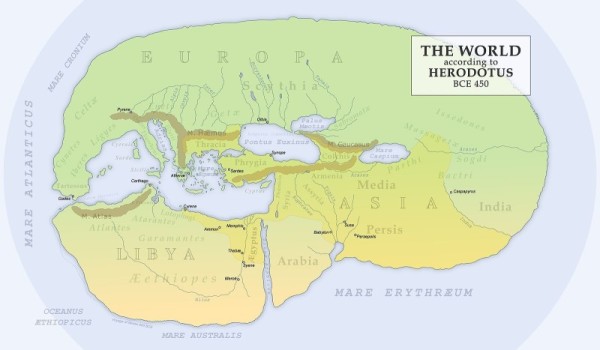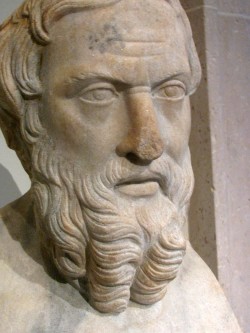. . . and the sand which is brought up contains gold. To obtain this sand the Indians make expeditions into the desert, each one having yoked together three camels . . . .

Translated by George C. Macaulay — our special project presenting the complete Herodotus with URLs for all of those people, places, events, and things which baffles and discourages modern readers.
Previously on Herodotus
104. The Indians, I say, ride out to get the gold in the manner and with the kind of yoking which I have described, making calculations so that they may be engaged in carrying it off at the time when the greatest heat prevails; for the heat causes the ants to disappear underground. Now among these nations the sun is hottest in the morning hours, not at midday as with others, but from sunrise to the time of closing the market: and during this time it produces much greater heat than at midday in Hellas, so that it is said that then they drench themselves with water. Midday however has about equal degree of heat with the Indians as with other men, while after midday their sun becomes like the morning sun with other men, and after this, as it goes further away, it produces still greater coolness, until at last at sunset it makes the air very cool indeed.
105. When the Indians have come to the place with bags, they fill them with the sand and ride away back as quickly as they can, for forthwith the ants, perceiving, as the Persians allege, by the smell, begin to pursue them: and this animal, they say, is superior to every other creature in swiftness, so that unless the Indians got a start in their course, while the ants were gathering together, not one of them would escape. So then the male camels, for they are inferior in speed of running to the females, if they drag behind are even let loose from the side of the female, one after the other; the females however, remembering the young which they left behind, do not show any slackness in their course. Thus it is that the Indians get most part of the gold, as the Persians say; there is however other gold also in their land obtained by digging, but in smaller quantities.

CC BY-SA 2.0 image from Wikipedia.
99. Others of the Indians, dwelling to the East of these, are pastoral and eat raw flesh: these are called Padaians, and they practice the following customs: -— whenever any of their tribe falls ill, whether it be a woman or a man, if a man then the men who are his nearest associates put him to death, saying that he is wasting away with the disease and his flesh is being spoilt for them: and meanwhile he denies stoutly and says that he is not ill, but they do not agree with him; and after they have killed him they feast upon his flesh: but if it be a woman who falls ill, the women who are her greatest intimates do to her in the same manner as the men do in the other case. For in fact even if a man has come to old age they slay him and feast upon him; but very few of them come to be reckoned as old, for they kill every one who falls into sickness, before he reaches old age.
100. Other Indians have on the contrary a manner of life as follows: -— they neither kill any living thing nor do they sow any crops nor is it their custom to possess houses; but they feed on herbs, and they have a grain of the size of millet, in a sheath, which grows of itself from the ground; this they gather and boil with the sheath, and make it their food: and whenever any of them falls into sickness, he goes to the desert country and lies there, and none of them pay any attention either to one who is dead or to one who is sick.
101. The sexual intercourse of all these Indians of whom I have spoken is open like that of cattle, and they have all one color of skin, resembling that of the Ethiopians: moreover the seed which they emit is not white like that of other races, but black like their skin; and the Ethiopians also are similar in this respect. These tribes of Indians dwell further off than the Persian power extends, and towards the South Wind, and they never became subjects of Darius.
102. Others however of the Indians are on the borders of the city of Caspatyros and the country of Pactyïke, dwelling towards the North of the other Indians; and they have a manner of living nearly the same as that of the Bactrians: these are the most warlike of the Indians, and these are they who make expeditions for the gold. For in the parts where they live it is desert on account of the sand; and in this desert and sandy tract are produced ants, which are in size smaller than dogs but larger than foxes, for there are some of them kept at the residence of the king of Persia, which are caught here. These ants then make their dwelling under ground and carry up the sand just in the same manner as the ants found in the land of the Hellenes, which they themselves also very much resemble in form; and the sand which is brought up contains gold. To obtain this sand the Indians make expeditions into the desert, each one having yoked together three camels, placing a female in the middle and a male like a trace-horse to draw by each side. On this female he mounts himself, having arranged carefully that she shall be taken to be yoked from young ones, the more lately born the better. For their female camels are not inferior to horses in speed, and moreover they are much more capable of bearing weights.
103. As to the form of the camel, I do not here describe it, since the Hellenes for whom I write are already acquainted with it, but I shall tell that which is not commonly known about it, which is this: the camel has in the hind legs four thighs and four knees, and its organs of generation are between the hind legs, turned towards the tail.
– Herodotus, Book III
| <—Previous | Master List | Next—> |
Herodotus made his living by being interesting. In a world where most people did not read and could not afford to buy a book even if they could, they would pay to listen to Herodotus recite from his books. They would not pay to be bored. In that world, the names that populate his stories would have some general familiarity to his audience. Their obscurity to us is a barrier that this series seeks to break down.
MORE INFORMATION
MAP LIBRARY
Because of lack of detail in maps as embedded images, we are providing links instead, enabling readers to view them full screen.

Leave a Reply
You must be logged in to post a comment.